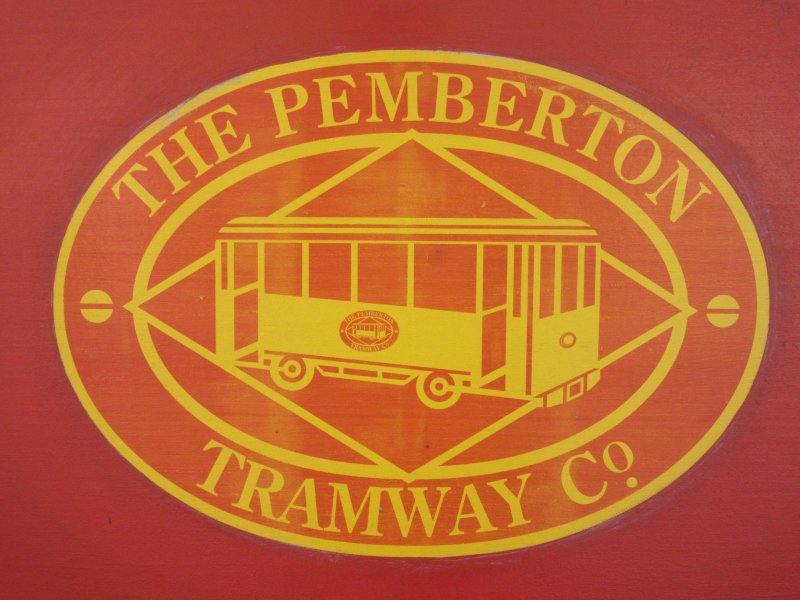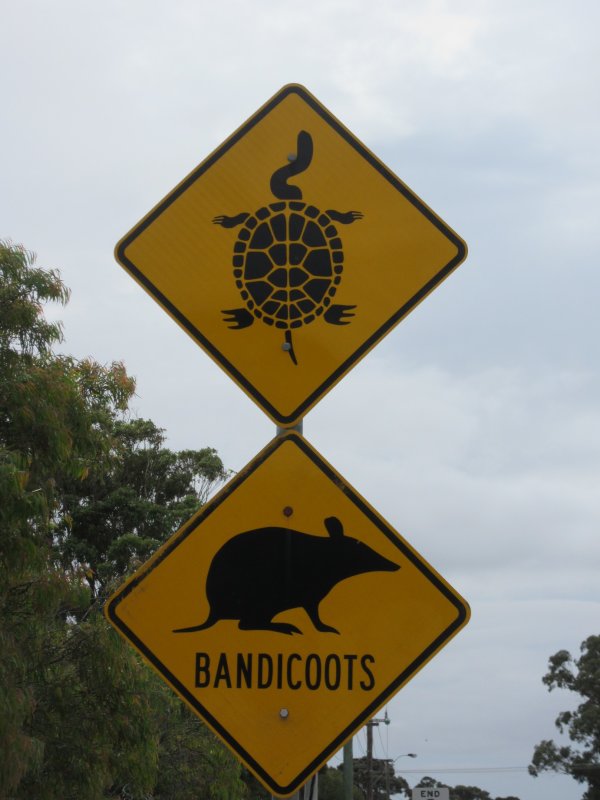
Pemberton Tramway - built 1929-33 |

Pemberton Railway Station |

Old locomotive |

Our tram |

Pete ready for the journey |

The route travelled through karri, jarrah and marri forests |

Over some very old bridges |

We stop at Cascades |

It's summer - the water is low |

Lefroy Brook |

The driver has a great view |

Through the forest |

Another old bridge |

Jarrah Jack's Brewery |

Lovely rolling hills and red earth |

Vineyards all around |

Lunch, a local wine and a beer tasting paddle |

Spotted this colourful tree in Pemberton |

Gloucester Tree - a bushfire lookout tree |

You can climb up this 53m karri tree |

Pegs are hammered into the tree to act as a ladder... |

...and a cabin built on top...built 1937-52 |

Pete climbing up |

Pete and Jackie on the pegs |

Pete looking down |

Pete at the top |

View from the lookout |

Little hatch to get into the cabin |

Forest all around |

The pegs wobble a little as you step on them |

Jackie at the bottom of the tree (her ankle has still not recovered fully from Mexico) |

Jackie did go higher than this but Pete refused to take a photo |

More people climbing... |

...up and up they go |

On our drive west |

Lookout near Walpole |

Walpole-Nornalup NP |

Valley of the Giants... |

...a treetop walk that takes you up... |

...into the canopy... |

...of beautiful tingle trees |

Looking up as we climb higher |

Pete on the walkway |

The walkway helps protect the sensitive tingle tree roots |

Looking down - it's hard to get a photo of the entire tree, they are so tall |

The walkway rises further... |

...until we're at the treetops |

We get great views |

The highest level is at 40m |

Grandma Tingle - can you see her face? |

Many tingle trees have been burnt inside by bushfire but they will survive... |

...and continue to grow, they also house tiny southern forest bats, maximum body length of 47mm |

This bulge is a burl - caused by insect, mite, bacterial or fungal attack - the tree forms a protective growth around the wound |

Pete walking on the Ancient Empire Boardwalk trail |

King Tingle |

Denmark River |

Australian White Ibis |

Boston Brewery - lunch and beer |

Boston Brewery - near Denmark |

Our campsite - shaded peppermint trees - heading down to the beach |

Parry Beach |

In for a swim |

First underwater photo with new camera |

Jackie back on the beach |

Waves all around |

The wind is picking up... |

...the surfers... |

...will be out on the waves soon |

Walking back to our camping spot |

Look out for snakes |

Gotta love Aussie humour |

Parry Beach - next to our campsite |

National Anzac Centre - this museum remembers the men & women (from all over Oz) who left by convoy from Albany to fight in WWI |

Australian & New Zealand troops at the Great (Cheops) Pyramid in Egypt |

Copper sculpture - Anzac Spirit... |

..."Sharing the last of the water with my old mate, he deserves a drink as much as I before the charge" |

In the 1930s Ataturk visited Australia |

Princess Royal Fortress - inside the guard house |

We laughed (sorry) at the emergency evacuation plan inside the very small guard house |

Princess Royal Fortress (1893) - huge guns to defend Albany |

Another huge gun |

Views from the top of Mt. Adelaide... |

...a great spot to help defend the city |

Ataturk Entrance to Princess Royal Harbour |

A ship coming into the harbour |

Wood chips for export |

Desert Mounted Corps Memorial - for WWI soldiers who fought at the Nek in the Gallipoli campaign of 1915 |

Brig Amity (replica) - built 1816 - carried Albany's first British settlers from Sydney in 1826 |

Middleton Beach - Emu Point in the distance - where we camped |

Emu Point Beach |

Watch out for bandicoots and wee turtles on the road |

Torndirrup NP - The Gap... |

...a natural cleft in the rock, channelling surf through walls of granite |

Looking down from the walkway over the sea |

Beautiful beaches all around |

The Natural Bridge |

Cheynes Beach Historical Whaling Station - Cheynes IV whale chaser |

We explore the boat |

The harpoon used to kill the whales |

View from the whale chaser looking out to King George Sound |

The engine room |

The whales were followed using sonar equipment and when they surfaced they were chased |

The captain was also responsible for firing the harpoon |

The whale would be brought alongside (fastfish); pumped full of air; attached to a radio beacon, cut free & picked up later |

Flensing - blanket pieces of blubber are removed with the help of flensing (Norwegian word) knives |

All of the whale goes in for cooking - although the teeth are saved, as they are ivory |

The cutting area |

The bits of whale were put into these holes for cooking |

The cookers underneath the deck |

These tanks stored whale oil |

Bits that remained were dried off and used as fertiliser and animal feed |

Pygmy Blue Whale skeleton - 22m |

Humpback Whale - not a toothed whale but a baleen whale |

Baleen Plates - when the whale expels a mouthful of water, they act as a strainer, catching small fish, krill & plankton |

Sperm Whale skelton |

Whaling ended here in 1978 - the last station in Australia - the water and the beach are no longer red |

Two men enjoying a spot of fishing but the bird got there first! |











